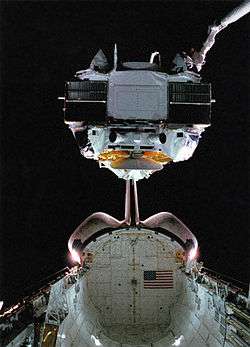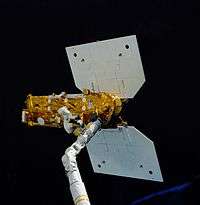List of heaviest spacecraft
The heaviest artificial objects to reach space include space stations, various upper stages, and discarded Space Shuttle external tanks. Spacecraft may change mass over time such as by use of propellant.





Between 1994 and 1998 the Shuttle-Mir complex of docked spacecraft was the heaviest artificial object in orbit (when docked), growing heavier from its start as Mir continued to be expanded.[1] It weighed at least 250 tonnes (250 long tons; 280 short tons) in a 1995 configuration.[2]
Currently the heaviest spacecraft is the International Space Station, nearly double Shuttle-Mir's mass in orbit. It began assembly with a first launch in 1998, however it only attained its full weight in the 2010s, due to its modular nature and gradual additions. Its mass can change significantly depending on what modules are added or removed.
All numbers listed below for satellites use their mass at launch, if not otherwise stated.
Selected spacecraft (by mass)
| Name | Mass | Notes | Orbit | State | In service from |
|---|---|---|---|---|---|
| Space Shuttle orbiter docked to ISS | 541,128 kg (1,192,983 lb) | International Space Station and later flights of the Space Shuttle program - particulary STS-134 | LEO | In Service (shuttle retired) | 1998 - 2011 |
| ISS | 419,455 kg (924,740 lb) | International Space Station | LEO | In Service | 1998– (at present size: 2011–) |
| Mir-Shuttle complex | 200,000–250,000 kg (440,925–551,156 lb) | Russian-U.S. project[1][3] | LEO | Retired/Deorbited 2001 | 1994–1998 |
| Mir | 129,700 kg (285,940 lb) | Soviet / Russian Space Station | LEO | Deorbited 2001 | 1986–2001 |
| Space Shuttle Atlantis on STS-117 | 122,683 kg (270,470 lb) | U.S. crewed reusable orbiter on its heaviest flight | LEO | Retired | 1985–2011 |
| Space Shuttle Endeavour on STS-134 | 121,830 kg (268,589 lb) | International Space Station and Space Shuttle Endeavour | LEO | Retired | 1992 - 2011 |
| Buran | 105,000 kg (231,485 lb) | Soviet reusable orbiter, made single flight | LEO | Retired | 1988–1988 |
| Space Shuttle Columbia on STS-2 | 104,647 kg (230,707 lb) | (A low mass mission for the shuttle.) Test flight of Space Shuttle Columbia | LEO | Destroyed | 1981 - 2003 |
| Skylab | 77,111 kg (170,001 lb) | U.S. Space Station; largest station orbited in one launch | LEO | Deorbited 1979 | 1973–1979 |
| Apollo CSM | 28,800 kg (63,493 lb) | U.S. crewed spacecraft for entering lunar orbit | Moon | Retired | 1968–1975 (Block II) |
| ATV | 20,293 kg (44,738 lb) | European cargo spacecraft on its heaviest flight | LEO | Retired | 2008-2014 |
| Salyut 7 | 19,824 kg (43,704 lb) | USSR Space Station | LEO | Deorbited 1991 | 1982–1991 |
| KH-11 | ~19,600 kg (43,211 lb)[4] | Electro-optical reconnaissance satellite | SSO | In Service | 1976– (current version: 2005–) |
| Salyut 1 | 18,425 kg (40,620 lb) | USSR Space Station | LEO | Deorbited 1971 | 1971–1971 |
| TKS | 17,510 kg (38,603 lb) | Soviet crewed spacecraft | LEO | Retired | 1977–1985 |
| Proton satellite | 17,000 kg (37,479 lb) | Space research satellite | LEO | Deorbited 1969 | 1965–1969 |
| Apollo Lunar Module | 16,400 kg (36,156 lb) | U.S. crewed lunar lander | Moon | Retired | 1968–1972 |
| Compton Gamma Ray Obs. | 16,329 kg (35,999 lb) | Space observatory[5] | LEO | Deorbited 2000 | 1991–2000 |
| Lacrosse | 14,500 kg (31,967 lb)- 16,000 kg (35,274 lb) | Radar imaging reconnaissance satellite[6] | SSO | Retired | 1988-2005 |
| Hubble Space Telescope | 11,110 kg (24,493 lb) | Space observatory[7] | LEO | In Service | 1990– |
| Tiangong-2 | 8,600 kg (18,960 lb) | Chinese Space Station | LEO | Deorbited 2019 | 2016-2019 |
| Tiangong-1 | 8,506 kg (18,753 lb) | Chinese Space Station | LEO | Deorbited 2018 | 2011–2016 |
| Envisat | 8,211 kg (18,102 lb) | Earth observing satellite[8][9] Kessler syndrome threat[10] | LEO | In Orbit, Inoperable | 2002–2012 |
| Comparison only | |||||
| Heaviest commercial geosynchronous communication satellites |
~7,000 kg (15,432 lb) | Communications satellite | GEO | N/A | N/A |
| Soyuz | 7,080 kg (15,609 lb) | Russian crewed spacecraft (latest revision used for mass) | LEO | In Service | 1967– (current version: 2016–) |
| Telstar 19V | 7,075 kg (15,598 lb) | Communications satellite | GEO | In Service | 2018– |
| TerreStar-1 | 6,910 kg (15,234 lb) | Communications satellite | GEO | In Service | 2009– |
| EchoStar XXI | 6,871 kg (15,148 lb) | Communications satellite[11] | GEO | In Service | 2017– |
| Intelsat 35e | 6,761 kg (14,905 lb) | Communications satellite | GEO | In Service | 2017– |
| UARS | 6,540 kg (14,418 lb) | Earth science[12] | LEO | Deorbited 2011 | 1991–2005 |
| Chandra X-ray Obs. | 5,865 kg (12,930 lb) | Space observatory[13] | HEO | In Service | 1999–present |
| GSAT-11 | 5,854 kg (12,906 lb) | Heaviest Indian Communication satellite | GEO | In service | 2018-present |
| Cassini-Huygens | 5,655 kg (12,467 lb) | Saturn orbiter and Titan probe [14] | Saturn | Deorbited 2017 | 1997–2017 |
| Terra | 4,864 kg (10,723 lb) | Earth observing satellite | GEO | In Service | 1999– |
| ExoMars Trace Gas Orbiter | 4,332 kg (9,550 lb) | Mars orbiter (including Schiaparelli EDM lander)[15] | Mars | In Service | 2016– |
| GPS IIIA | 3,880 kg (8,554 lb) | Current GPS Satellite series | MEO | In Service | 2018– |
| Spektr-R (RadioAstron) | 3,660 kg (8,069 lb) | Space observatory[16] | HEO | In Service | 2011– |
| Juno | 3,625 kg (7,992 lb) | Jupiter orbiter[17] | Jupiter | In Service | 2011– |
| Herschel | 3,400 kg (7,496 lb) | Space observatory | Earth-Sun L2 | Retired | 2009–2013 |
| Galileo | 2,562 kg (5,648 lb) | Jupiter orbiter and probe[18] | Jupiter | Deorbited 2003 | 1989–2003 |
| MAVEN | 2,454 kg (5,410 lb) | Mars orbiter[19] | Mars | In Service | 2013– |
| Lunar Reconnaissance Orbiter | 1,846 kg (4,070 lb) | Lunar orbiter[20] | Moon | In Service | 2009– |
| Astrosat |
1,513 kg (3,336 lb) |
India's first dedicated multi wavelength space telescope-Space Observatory | Near Equatorial Orbit | In Service | 2015– |
| Mars Orbiter Mission | 1,337.2 kg (2,948 lb) | India's first Mars mission | Mars | In Service | 2013– |
| Venus Express | 1,270 kg (2,800 lb) | Venus orbiter | Venus | Deorbited 2015 | 2005–2014 |
| MESSENGER | 1,093 kg (2,410 lb) | Mercury orbiter[21] | Mercury | Deorbited 2015 | 2011–2015 |
| Voyager 1 / Voyager 2 | 815 kg (1,797 lb) | Outer planets / interstellar space[22] | Solar Escape | In Service | 1977– |
| New Horizons | 465 kg (1,025 lb) | Pluto/Kuiper belt probe[23] | Solar Escape | In Service | 2006– |
See also
- List of large reentering space debris
- Lists of spacecraft
References
- "Mir Space Station". nasa.gov. Retrieved 16 September 2017.
- David S. F. Portree (March 1995). "Mir Hardware Heritage" (PDF). ston.jsc.nasa.gov. NASA. Archived from the original (PDF) on 3 August 2009. Retrieved 30 March 2007.
- Broad, Willaim J. (29 June 1995). "Shuttle Set for Rendezvous Today With Russia's Mir". New York Times. Retrieved 16 September 2017.
- Richelson, Jeffrey T. (2001). The Wizards of Langley. Inside the CIA's Directorate of Science and Technology. Westview Press, Boulder. ISBN 0-8133-4059-4.p.199-200
- "Compton Gamma-Ray Observatory". NASA Space Science Data Coordinated Archive. Retrieved 16 September 2017.
- "Onyx 1, 2, 3, 4, 5 (Lacrosse 1, 2, 3, 4, 5)". space.skyrocket.de. Retrieved 30 December 2018.
- "Fact Sheet". ESA/Hubble. Retrieved 16 September 2017.
- "Envisat Space Segment". ESA Earth Online. Retrieved 16 September 2017.
- "Envisat Orbit". Heavens Above. Retrieved 16 September 2017.
- Gini, Andrea (25 April 2012). "Don Kessler on Envisat and the Kessler Syndrome". Space Safety Magazine. Retrieved 9 May 2012.
- "EchoStar 21". Retrieved 6 July 2017.
- Justin Mullins; Paul Marks (20 September 2011). "Hardy 6-tonne satellite falls to Earth". New Scientist. Retrieved 25 September 2014.
"This is the largest NASA satellite to come back uncontrolled for quite a while," says Nick Johnson, chief scientist for NASA's Orbital Debris Program Office at the Johnson Space Center in Houston, Texas.
- "Chandra X-ray Observatory Quick Facts". Marshall Space Flight Center. Retrieved 16 September 2017.
- "Cassini". NASA Space Science Data Coordinated Archive. Retrieved 16 September 2017.
- Elizabeth Gibney (11 March 2016). "Mars launch to test collaboration between Europe and Russia". Nature News. Retrieved 14 March 2016.
- "RadioAstron User Handbook" (PDF). RadioAstron Science and Technical Operations Group. 29 July 2015. Retrieved 16 September 2017.
- "Juno Mission to Jupiter" (PDF). NASA FACTS. NASA. April 2009. p. 1. Retrieved 16 September 2017.
- "Galileo Jupiter Arrival" (PDF) (Press Kit). NASA / Jet Propulsion Laboratory. December 1995. Retrieved 16 September 2017.
- Graham, William (17 November 2013). "Atlas V launches MAVEN en route to Martian adventure". NasaSpaceFlight.com.
- "Lunar Reconnaissance Orbiter (LRO)". NASA Space Science Data Coordinated Archive. Retrieved 16 September 2017.
- "MESSENGER". NASA Space Science Data Coordinated Archive. Retrieved 16 September 2017.
- "Voyager 1". Goddard Space Flight Center. Retrieved 16 September 2017.
- "New Horizons Pluto Kuiper Belt Flyby". NASA Space Science Data Coordinated Archive. Retrieved 16 September 2017.